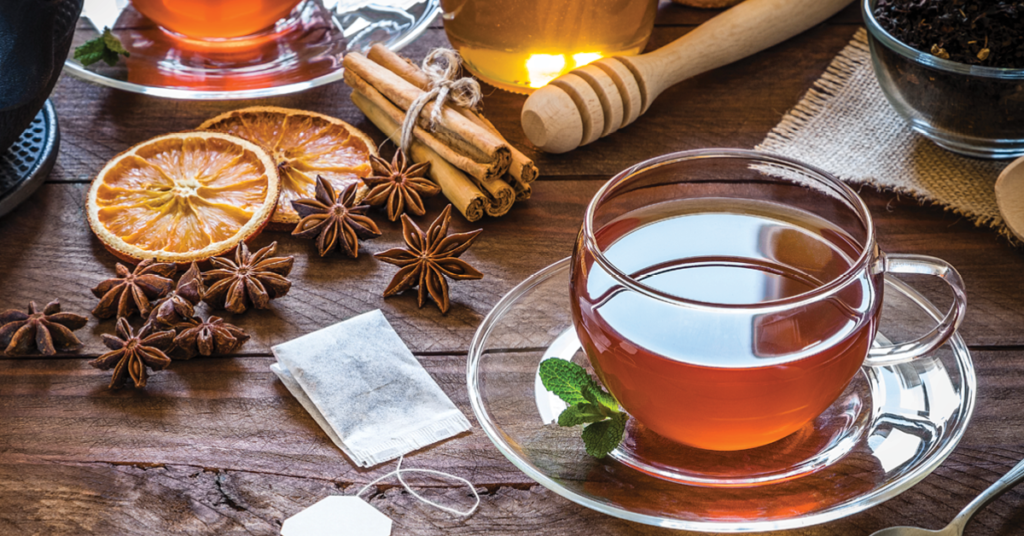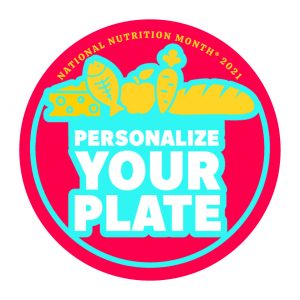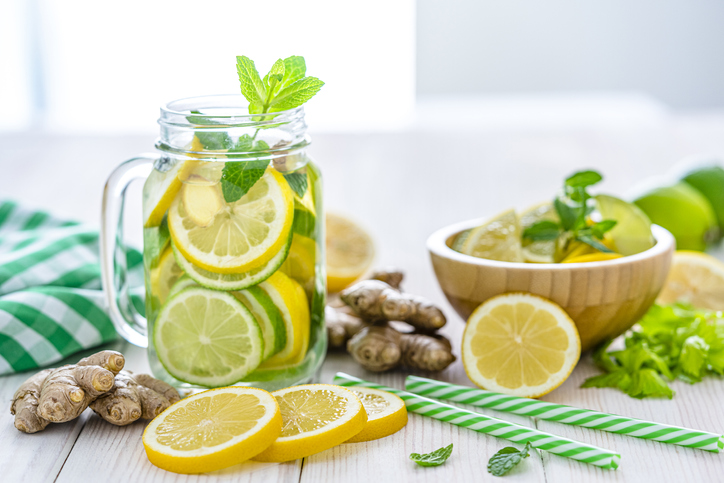
Tea Up for Well-Being
Ellie Wilson
MS, RDN
As the evenings turn cooler, our beverage choices also shift to warmer temperatures and more comfort and health-oriented drinks. Tea is the most popular beverage in the world, second only to water, and has a range of flavors, benefits, and culinary applications.
Tea has a simple recipe – water and some form of the leaves of the Camelia Sinensis bush, it is most often made with hot or warm water, but can be made with cool water, such as “sun tea”. That simplicity earns it a spot on the list of whole foods, or more accurately, whole food-derived drinks. Interesting to note that America is the primary country where tea is enjoyed cold – the demand for functional beverages that are portable and personal has created a unique opportunity for tea as a grab-and-go beverage. Approximately 75 – 80% of tea consumed in America is iced. ¹
The first written records of tea as a medicinal beverage were found in China, around the 3rd century A.D. Modern research has been able to identify specific compounds that may have health benefits, including polyphenols such as flavonoids, theaflavins and catechins, all antioxidants. Observation studies connect 2 -3 cups of tea per day to reduced risk of premature death, heart disease, stroke and type 2 diabetes. More research must be done to define intake and specific health impact, but tea has a place on the table for traditional teetotalers and health seekers alike.
Generally, caffeine content of a cup of tea is 50 mg or less, half the content of an 8 oz cup of coffee. ² Time brewing and form of tea also impact caffeine content. Tea assists with hydration, and contains the amino acid theanine, which research hints supports brain health. This makes it a perfect beverage for that afternoon energy-seeker, busy parents recharging between work and evening family activities, or an end-of-day stress soother.
Tea is also riding the innovation wave as more functional beverages that include nootropics, ingredients that enhance energy, focus, and relaxation, or added vitamins and minerals. Culinary innovations include using flavored teas (such as green tea with lemon) as a poaching liquid for seafood or chicken, or macha (green) tea powder as an ingredient in baked or dessert items. Tea is even in barbeque sauce!
I had the opportunity to see a tea plantation and enjoy a tea ceremony in Japan. The evergreen shrubs were beautiful and carefully tended. Tea grows at higher elevations in many Asian countries – it was a beautiful landscape and is where I was first introduced to green tea.
Tea flavors are shaped by the terroir or soil/climate/altitude of the place it is grown. ³ They are also defined by the part of the plant that it is made from, and the types of processing those plant elements are subjected to. Finally, they may be enhanced by essential oils, or combinations with other plants, such as herbs or spices (such as Chai, a tea spiced with cardamom and cinnamon). Tea truth – beverages made with herbs, spices, flowers and other plants that do not include the Camelia Sinensis leaves are not teas – they are tisanes. That term is more technical – “herbal tea” is a more consumer-friendly description and has become the more common term used for those brewed beverages.
Take some time to explore the amazing world of tea with the many varieties and flavors you can find in stores. You will find yourself in good company – 159 million Americans enjoy tea each day! ⁴
¹, ⁴https://www.teausa.com/teausa/images/Tea_Fact_2021.pdf
²IFIC, accessed 9/7/22, https://foodinsight.org/coffee-and-tea-can-hydrate-too/
³Tea Aroma Formation https://www.sciencedirect.com/science/article/pii/S221345301500018X

Tips for A Happy and Food Safe Halloween
BOO! Here it comes again, the official (unofficial) holiday of Halloween! There is no doubt, it is beloved by children and adults alike. The costumes, decorations and freaky/fun tricks and treats are wickedly delightful for those who participate before colder weather changes activity opportunities. To ensure it is fun for everyone, set expectations – your goblins and ghouls should know the food safety rules ahead of time to set the stage for happy smiles versus scowls and howls. Here are some ‘tricks” for caregivers hoping for a howling good time!
- Eat before you go out – some great Halloween treat ideas to set the stage are right here (with spooky music!) on Price Chopper YouTube and Pinterest boards. That will make it easier to create the plan that parents/guardians must check items before eating. We have treats for adults too – pumpkin everything and fall favorites to fuel your fun.
- Children should be taught/shown not to accept treats that aren’t commercially wrapped. Throw away anything that is torn, has pinholes, or looks unusual in any way. Fresh fruit, if accepted, should be carefully checked and washed before eating.
- If your child has a food allergy, you already know that treats are tricky. Verify Epi-pens are not expired and are readily available. Always check the labels of each item. Some homes may have a teal-colored pumpkin to signal they have some treats without some allergens, but adults must still check the individual items before eating. The same goes for gluten free candy – The Celiac Disease Foundation has published their 2022 Gluten Free Halloween Candy list – you can download and print the pdf here.
- Ages and stages – some candies are choking hazards for smaller children. Gum, hard candies, peanuts and even small toys could be a concern.
- How much and how often should be part of the plan – a national poll shows 78% of parents plan for about two pieces of candy per day. That helps children learn candy can be part of eating well.
- Flashlights, candy, party supplies and more are all at your local store and online waiting for you to create a “monster” good time. Happy Halloween!
BWAH HA HA HAAAAA!!!!!!!

Get Your Pet Meds at Price Chopper
At Price Chopper/Market 32, we are passionate about supplying our customers with everything they need to keep themselves and their families healthy. Of course, pets are always included in that! We strive to provide the resources they need to live happy. Did you know you can pick up your pet medications from our pharmacies? It’s true! We offer affordable prices and an easy pick-up process at our in-store pharmacies.
We offer top brands like Bavecto, Frontline, and Seresto for fighting fleas & ticks, Bravecto requires a healthcare provider prescription. New, transferred, and authorized refills are included as ordered by a prescriber. Also, your pet is covered with a number of prescription meds for various ailments: Carprofen for arthritis/joint pain in cats and dogs, Heartgard Plus for Heartworm in dogs, eye meds such as Latanoprost, Dorzolamide, and Diclofenac, Levothyroxine for thyroid in dogs, and Vetsulin for diabetes in dogs and cats. For more information please visit our website.
Can’t pick up? Medications can also be delivered via ScriptDrop. Whether it’s to your home, office, or assisted living facility, prescriptions can be hand-delivered by a professional and HIPAA compliant ScriptDrop courier. Click here to find delivery options and participating locations near you!
We believe all good patients deserve a nice, healthy treat so check out our selection of pet treats, sure to make your furry friend smile!
Shop Pet Treats

Why You Should Get Your Flu Shot Every Year
by Angelique Harris
With COVID-19 still maintaining its hold on the world’s health systems, it is important to not disregard the seasonal influenza virus. With flu season rapidly approaching there are many reasons why it is more vital than ever to get vaccinated. Not only will your vaccination contribute to herd immunity protecting those that are unable to get vaccinated, but it also helps reduce flu-related hospitalizations, allowing health care workers to continue to focus on treating patients with COVID-19 and conserving medical resources.
Influenza is very commonly overlooked, and many are unaware of the potential seriousness that it holds as it can be deadly. Approximately, 35.5 million Americans contracted the flu during the 2018-2019 flu season and from those 34,200 individuals died from the illness.1 During the 2019-2020, the flu vaccine prevented an estimated 7.5 million influenza cases, 105,000 associated hospitalizations and 6,300 flu-related deaths. A study conducted in 2014, published in the Journal of Infectious Diseases reported that the flu vaccine prevented pediatric intensive care unit (PICU) admission by 74% from 2010-2012.2
How do flu vaccines work? The influenza virus infects our body by attacking our own cells and modifying the DNA within our cells to create more virus. The flu vaccine is formulated every year in time for flu season. They are made up from inactivated strains of the influenza virus.2 Once vaccinated, the immune system recognizes the foreign invader and quickly starts up the immune response to create antibodies which are cells within our body that can target the virus and extinguish it without affecting our own cells. Since the pathogen has been modified or is already dead, the immune system is able to create antibodies that the body will then use if exposed to a live virus. Therefore, you cannot get the flu from receiving the flu vaccine since it does not have the ability to infect the cells. One important thing to note is that the antibodies generally take a week or more to develop to achieve the full protection offered from the vaccine.3
Why do I need a new vaccine every year? The influenza virus is a master of disguise. Every year it changes its appearance to one that our bodies are not familiar with. With this change in appearance, if you had not gotten vaccinated and you were exposed to the virus, the body would then have to fight harder to prevent the spread of the virus as well as make the antibodies to fight off the infection. During this time, the body has other methods to prevent the spread of infection such as increasing internal body temperature (fever) pulling protein from the body’s muscles (muscle aches), along with washing the germs from the nasal and respiratory system (runny nose, coughing).4
Getting vaccinated can do more than protect yourself from the flu. Herd immunity is what occurs when a vast majority of the population is vaccinated thus making it difficult for the virus to spread. This type of immunity is beneficial to young infants and immunocompromised individuals to have some form of protection.5 People with chronic medical conditions such as heart disease and asthma are at high risk for serious complications leading to possible life-threatening pneumonia.
Getting the flu vaccine is a small act that can have a big impact on protecting those around you and the community.
Sources
- What are the benefits of flu vaccination? [Internet]. Center for Disease Control, National Center for Immunization and Respiratory Diseases. 2021 8 June. [cited 2021 Aug 10]. Available from: https://www.cdc.gov/flu/prevent/vaccine-benefits.htm
- How the Immune System Protects You From Infection [Internet]. Pfizer Pharmaceuticals. [cited 2021 Aug 10]. Available from: https://www.pfizer.com/news/hot-topics/how_the_immune_system_protects_you_from_infection
- Haelle, Tara. Why You Need the Flu Shot Every Year. [Internet]. The New York Times. 2017 Dec 1. [cited 2021 Aug 10]. Available from: https://www.nytimes.com/2017/12/12/smarter-living/why-you-need-the-flu-shot-every-year.html
- How Your Body Fights Off Cold and Flu [Internet]. Vicks. Proctor & Gamble. [cited 2021 Aug 10]. Available from: https://www.vicks.com.au/en-au/science-of-healing/understanding-types-of-illness/how-your-body-fights-off-cold-and-flu
- Franco, Cheryl. Getting the Flu (Influenza) Vaccine: Why It’s Important [Internet]. Children’s Hospital of Los Angeles. [cited 2021 Aug 10]. Available from: https://www.chla.org/blog/rn-remedies/getting-the-flu-influenza-vaccine-why-it-s-important

How the Flu Vaccine Can Help with Severe Symptoms of COVID-19
by Angelique Harris
With the pandemic still trekking on with the new circulating Delta variant, it is more important than ever the ensure you and your family’s safety. Recent studies have found promise that the flu vaccine may provide protection against severe symptoms of COVID-19. Both viruses have in the past lead to a multitude of hospitalization requirements for American’s and both have the potential to be fatal.
The European Congress of Clinical Microbiology & Infectious Disease analyzed patient data, noting the correlation of a reduced risk of stroke, sepsis, and deep vein thrombosis in COVID-infected patients who had received their flu vaccine. According to the study, the non-vaccinated individuals had a higher risk of 20% to be more likely to be admitted into the ICU. They also had a 45% higher chance of developing sepsis and were 58% more likely to suffer from a stroke.1 Additionally, patient’s vaccinated against the flu had a 25% lower chance of testing positive for COVID-19.2
The mechanism behind this protection provided from the flu vaccine is uncertain. Some researchers believe that it boosts the body’s natural immune system. It is also noted that some vaccines produce an adaptive immune response that can be activated in the presence of another foreign body, an example being how some tuberculosis vaccines has some efficacy against yellow fever and malaria.2
Children under the age of 13 may also be able to receive some protection against COVID-19 with the seasonal flu vaccine. The University of Missouri School of Medicine has found data to support children that received the flu shot are less likely to experience symptoms from COVID. Researchers reviewed more than 900 children in 2020. Professor, Anjali Patwardhan MD explains the concept of viral interference to which causes the cells within our body to become resistant to a second infection after first experiencing another. She believes this to be the correlated mechanism for the increased protection. Results from the study show that the children previously vaccinated for the flu and tested positive for COVID-19, were less likely to experience symptomatic disease. Dr. Patwardhan notes that research still needs to be conducted and its importance as children play a role influencing viral transmission.3
While the flu vaccine is not a replacement for the vaccines approved for COVID-19, it may serve importance in areas where COVID vaccination rates are struggling, or other countries not expected to receive shipments of the vaccine until 2023. These statistics may also provide some comfort to those hesitant to receive the COVID vaccines.1 With both viruses sharing similar seasonal outbreaks, it is important to ensure the highest protection.
Sources:
- Antrim, Aislinn. Study Finds Flu Shots Protect Against Some Severe COVID-19 Symptoms [Internet]. Pharmacy Times; 2021 July 15. [Cited 08/12/2021]. Available from: https://www.pharmacytimes.com/view/study-finds-flu-shots-protect-against-some-severe-covid-19-symptoms
- Jeremias, Skylar. Flu Vaccine May Protect Against COVID-19 Infection [Internet]. AMJC; 2021 Feb 24. [Cited 08/12/2021]. Available from: https://www.ajmc.com/view/flu-vaccine-may-protect-against-covid-19-infection
- Study Shows Flu Vaccine Lessens COVID-19 Symptoms in Children [Internet]. University of Missouri School of Medicine; 2021 Feb 4. [cited 08/12/2021]. Available from: https://medicine.missouri.edu/news/study-shows-flu-vaccine-lessens-covid-19-symptoms-children

Why Do Older Adults Need A Different Flu Shot?
by Angelique Harris
It is no secret that our bodies go through a handful of changes as we age. One of things that many people don’t think about is what happens to the immune system. Older adults tend to have a weaker immune system and are therefore at higher risk for infection. With flu season coming around the corner it is important that we make sure everyone gets the flu shot best suited for them. For adults older than the age of 65 it is recommended to get the high-dose flu vaccine. The high dose vaccine contains higher amount of viral protein intended to result in a stronger immune response than the regular flu vaccine.1
There are many factors that affect the level of risk an individual has for developing a serious infection from the influenza virus. One important factor to consider is age. For adults 65 years and older, there is a high risk of developing complications from the influenza virus sometimes requiring hospitalization. Studies produced by the Center of Disease Control, estimate that this age group results in 70% to 85% of flu-related deaths and 50% to 70% of flu-related hospitalizations each year.2 When provided the regular flu vaccine over the senior one, studies found that older adults had 50% to 75% fewer antibodies than the younger population.3
A new flu vaccine is produced each year by estimating certain viral strain to determine which combination is likely to provide the greatest protection. Since this is an estimation, the efficacy rates each year are variable, however, there are multiple studies that have found that the flu vaccine is effective in preventing doctor visits and hospitalizations due to complications from the flu. When compared, patients 65 years and older, the recommended high dose vaccine produced a stronger immune response than the standard trivalent used in the younger population and resulted a 24% higher efficacy rate. A study in the Lancet Respiratory Medicine Journal, found that the Fluzone high dose also corresponded to a lower risk of hospital admissions.3
Some individuals do experience mild side effects. These side effects include redness, soreness, swelling along with fever, headache, and fatigue. These side effects may last for a few days and do not compare in severity to the common side effects of the actual flu. While the vaccine does provide some protection, like all vaccines it is not 100%. Other methods to reduce the spread of influenza include frequent handwashing, disinfecting commonly touched surfaces and staying home when you feel sick.4
While the efficacy of the flu vaccine varies each year, it is still important to get vaccinated. For the older population, the vaccine may be the difference between life or death. Influenza can lead to further complications such as pneumonia as well as worsen pre-existing lung and heart conditions.5 These worsening symptoms can require professional treatment and support requiring doctor visits as well as hospitalizations. Although it may not prevent you entirely from getting the flu, it will likely ensure the symptoms to be far less severe. Not only can getting vaccinated help protect yourself but also help protect others around you unable to receive vaccinations.
Sources:
- Flu & People 65 Years and Older. [Internet]. Centers for Disease Control and Prevention: US Department of Health and Human Services; 2021 May 6 [cited Aug 11, 2021]. Available from: https://www.cdc.gov/flu/highrisk/65over.htm
- Gillespie, Claire. What is the High-Dose Flu Vaccine, and Who Can Get It? Here’s What Infectious Disease Experts Say[Internet]. Health.com; 2021 Sept 4 [cited Aug 11, 2021]. Available from: https://www.health.com/condition/flu/high-dose-flu-vaccine
- Tosh, Pritish K M.D. High-dose flu vaccines: How are they different from other flu vaccines? [Internet]. Mayo Foundation for Medical Education and Research. 2021 April 23 [cited Aug 11, 2021]. Available from: https://www.mayoclinic.org/diseases-conditions/flu/expert-answers/fluzone/faq-20058032
- Why Seniors Should Get the Inactivated Influenza (Flu) Vaccine [Internet]. Health Link British Columbia. 2021 August [cited Aug 11, 2021]. Available: https://www.healthlinkbc.ca/healthlinkbc-files/inactivated-flu-vaccine-seniors
- Why seniors need extra flu protection [Internet]. UCI Health. The Regents o the University of California; 2020 Jan 7 [cited Aug 11, 2021]. Available from: https://www.ucihealth.org/blog/2020/01/senior-flu-shot

Health & Wellness with Tylenol
Eugene Kupiec, PharmD
Tylenol is the #1 doctor recommended brand for pain relief and fever reduction. This drug has been used for almost 70 years and millions of Americans trust Tylenol to get the job done every week! Tylenol can be used for nearly everyone ranging from infants to the elderly. Tylenol is NOT an NSAID like aspirin or ibuprofen, it works differently. It does not have the same blood “thinning” action as many NSAIDs do making Tylenol a great option for those already on blood thinners, those with a history of gastrointestinal bleeding, and anyone else who cannot take NSAIDs.
Pain hits fast and Tylenol is prepared to provide fast relief. Tylenol is available in caplets, liquids, and even in Rapid Release Gels. TYLENOL® Rapid Release Gels have laser drilled holes for release that helps the medication act fast for fast pain relief with the convenience of a capsule. Tylenol also has extended-release tablets for those with around the clock pain! Whether it’s a headache, fever, aches, or pains, Tylenol has been proven effective, but what about safety?
Safety
Tylenol is also called acetaminophen, paracetamol, or is sometimes abbreviated as “APAP”. It has been clinically proven to be safe and effective when taken as directed. It is important to read the box when taking Tylenol and follow the dosing instructions carefully. The maximum safe daily dose of Tylenol to be taken orally is 4000mg or 4g daily. That would be two extra strength tablets every 6 hours for 24 hours.
This dosing threshold is so important because Tylenol in larger doses than 4g per day can cause serious liver damage. For this reason, it is also important to look out for other medications that may have acetaminophen in them. Some branded medications that contain acetaminophen are Excedrin, Nyquil, Sudafed, Theraflu, Percocet, Fioricet, Ultracet, and Vicodin to name a few! If you are taking Tylenol, always check the label of a new medication to ensure you are not exceeding the 4g/day threshold. Now head over to your local Price Chopper or Market 32 and find the Tylenol product that is right for you! If you are unsure about a product or about safety, you can always ask your pharmacist or doctor.


March is National Nutrition Month!
Ellie Wilson
MS, RDN Manager, Lifestyles and Wellness
March is National Nutrition Month®, time to celebrate and activate to capture the bounty and benefits of food! National Nutrition Month® is an annual nutrition education initiative from the Academy of Nutrition and Dietetics. For 48 years, Registered Dietitian-Nutritionist members (now more than 100,000, the largest professional nutrition organization in the world), have led the food and health conversation, sharing all the benefits eating well and being active can bring to your life. The central theme for 2021, “Personalize Your Plate”, recognizes that family, history, culture and community all influence what we eat, and there are many flavorful, inspiring ways to bring food and health together.
If you believe there is room to get more benefits from the food you eat, check out some of my favorite tips and hacks from the Academy to power your plate in 2021:
- Take time to enjoy your food.
- Include healthful foods from all food groups.
- Use a grocery list to shop for healthful foods.
- Fuel for school or work with a delicious, nutritious breakfast.
- Keep healthy ingredients on hand.
- Keep food safety front and center.
- Share meals with family and friends, in your home and virtually!
- Hydrate healthfully.
- Learn how to read Nutrition Fact Panels.
- To get personalized nutrition advice to meet your goals, see a registered dietitian nutritionist!
Take credit for the good choices you are already making and consider what you could add to your efforts to enjoy a healthier lifestyle. Check out our website and learn more about the Know Your Colors nutrition guides, health and wellness articles on the Price Chopper blog and Pharmacy pages, Price Chopper You Tube videos, the Kids Cooking Club and the healthy recipes – explore the website and store for more information and inspiration. Enjoy eating well with us for National Nutrition Month!

Seafood Smarts for Heart and Health
Ellie Wilson
MS, RDN, Lifestyle and Wellness
If you are thinking more about eating well and supporting better health with food, you are not alone. The good news is, there is one move you can make to add foods that bring benefits for heart and mind at every age and stage – eat more seafood.
The Seafood Team at Price Chopper has gone hook, line and sinker off the deep end to make sure you have fresh, delicious choices. Waiting for you in the Seafood department, beautiful Fresh Chilean Salmon Fillet, amazing colossal scallops, (super tender and the perfect serving size for young children), premium shrimp and a wide variety of other fillet options are all ready for your favorite family-friendly Fast Fresh Beach Tacos recipe, a cutting edge twist on international flavors like Maple Gochujang Roasted Salmon with Shiitake Mushrooms Charred Red Cabbage, and grilled seafood recipes like Tequila Lime Shrimp Skewers with Grilled Fruit Salsa. Chef tip – many recipes are adaptable to your favorite seafood item, fresh or frozen, though cooking times may vary. Grilled recipes can also be oven-baked or broiled – make it your own!
Time-crunched? Seafood fits perfectly into a busy schedule, cooking up in an average of about 10 minutes. Catch a great deal and enjoy a M32 seafood and vegetable dinner with Seafood meals available in the GrabNGo case. Salmon Florentine Pinwheel with Broccoli is just one of these just-right portioned Market 32 Seafood Meals that bake in their own tray for quick cooking and cleanup. Watch for AdvantEdge bonus points – what a great way to benefit waist and wallet!
Need any more reasons to dive in? Seafood is a nutrient-dense food – lean protein, omega 3’s, Vitamin D, and minerals like iron, selenium, zinc and iodine are all part of the package seafood offers. That is straight from the updated recommendations released by the FDA and EPA last year. In this update, the FDA and EPA enhanced their recommendations and guidance with a Best and Good choices list, (more than 20 recommended items are in stores!) and shared some evidence-based guidelines for women who might become pregnant, breastfeeding mothers and young children. The 2020-2025 Dietary Guidelines for Americans, encourages starting children on seafood at 6 months or older – a bright beginning for smart food habits. Fresh, frozen and canned/pouch all count, and fit every appetite and budget. Only one third of Americans eat seafood each week, with the average intake just below 3 ounces per person – about half the twice-per-week recommendation of the American Heart Association and the Dietary Guidelines for Americans. So, get with the guidelines and enjoy more seafood each week!

10 Ways to Love Lemons and Limes
Lemons and limes are major culinary collaborators, complimenting and enhancing many flavors, used in beverages, baking, and dishes from breakfast to dessert. They are essential to some cuisines – lemons front and center in Mediterranean and Italian dishes, limes synonymous with Southwestern, Caribbean, Thai and Mexican specialties. Every chef, foodie and dietitian has favorite ways to use the juice, zest and fruit of these citrus superstars.
Good to know:
- Lemons and limes should be washed under cool running water before use.
- A large lime or medium lemon will yield about ¼ cup of fresh juice.
- Store lemons and limes in the refrigerator for up to 3 weeks
- Lemons and limes can be frozen – sliced in rounds or quarters, frozen individually on a parchment covered sheet pan, then bagged for use within 3 months.
- Add lemon or lime juice to pan sauces at the end of cooking, after removing from heat.
- Too much lemon and lime can curdle dairy – check ingredient ratios for best results.
- Lemon or lime juice can be used to minimize browning in apples and potatoes
- Fresh zest is best – lemon and lime zest lose flavor with exposure to air
- Lemon juice can substitute/reduce the need for added salt in some recipes.
Power pairings – lemons and limes are easy to use with a variety of herbs and spices. Check out this luscious list for some inspiration!
Lemons love:
Butter, basil, ginger, honey, pepper, rosemary, garlic, parsley, thyme, oregano, Dijon, parmesan, dill, blueberry, and raspberry.
Lavish limes in dishes with:
Coconut, curry, chili, cilantro, coconut, chipotle, mango, hoisin, red pepper, jalapeno, cranberry, raspberry, and blackberry.
Bring that zing to your table with some great recipes:
Chicken with Lemon Herb Mushroom Sauce
Leftover Lemony Pork Kale White Bean Fettuccine
Roasted Garlic Parmesan Dip (also a great sauce for chicken or seafood!)


